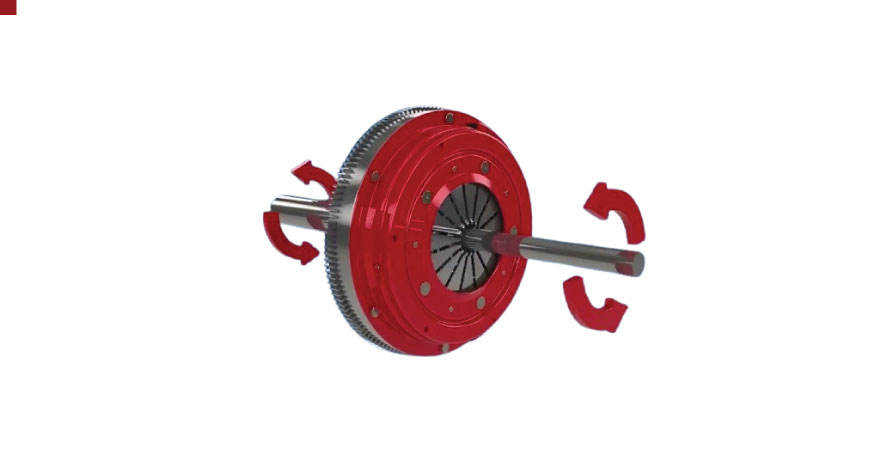The clutch is a mechanical device that engages and disengages the power transmission between the engine and the wheels. It is a very important component of manual transmission of vehicles that allows the driver to control the flow of power from the engine to the wheels. In a manual transmission car, the engine produces power continuously, but the wheels need to be disconnected from the engine when the vehicle is stationary or when the driver wants to change gears. Very easily the clutch temporarily disengages the connection between the engine and the gearbox.
The clutch consists of a few main parts, including a friction plate (clutch disc), a pressure plate, and a release bearing. When the driver presses the clutch pedal, the pressure plate releases its grip on the friction plate which allows the engine’s power to be temporarily disengaged from the gearbox. This allows the driver to change gears easily without damaging the transmission.
The clutch is an important component of a vehicle that facilitates smooth gear changes and allows the driver to control the transfer of power from the engine to the wheels in manual transmission vehicles.
HOW DOES CLUTCH WORK?
The Clutch operation is a basic skill for driving. Here are the basic steps to work the clutch in a car.
- Press the Clutch Pedal: The clutch pedal is usually located to the left of the brake pedal. Press the clutch pedal down with your left foot. This action disconnects the engine from the transmission which allows you to change gears without damaging the engine.
- Shift to Neutral: While holding the clutch pedal down, shift the gear lever to the neutral position. In neutral, no gears will be engaged and the engine is disconnected from the transmission.
- Start the Engine: The clutch pedal is still in the down position. Now start the engine. Keep the clutch pedal pressed down so that the car cannot move.
- Engage First Gear: With the engine running, depress the clutch pedal and shift the gear lever to the first gear. This will be the first gear when you start driving.
- Gradually Release the Clutch: While gradually releasing the clutch pedal, add a bit of gas with your right foot. The goal is to find the “biting point” or the point where the engine starts to engage with the transmission. You’ll feel a slight resistance. This is the point where the clutch begins to transmit power to the wheels.
- Drive Away: Once you’ve found the biting point, slowly release the clutch pedal while giving more gas. As you fully release the clutch pedal, the car will start moving forward.
- Shift Gears: To shift to higher gears, lift off the gas, depress the clutch pedal, shift to the desired gear, and release the clutch gradually while giving a bit of gas. For downshifting, depress the clutch, shift to the lower gear, and release the clutch slowly.
Practice in an open space, such as an empty parking lot, to get a feel for the clutch. Smooth coordination between releasing the clutch and pressing the gas is crucial for smooth driving.
It might take some time to get used to the clutch, but with practice, you’ll become more comfortable. Remember that the specific details might vary slightly depending on the make and model of the car.
To keep Thinking simple, check out this YouTube Video on how it works as they show you visually!
Luckily, you came to the right place and you don’t have to visit all over the place to find it! Everything you need to know about clutches is in this article. Below, is our catalog of high-quality, affordable clutches. Click on Buy Now! the link to purchase!
HOW TO REPLACE A CLUTCH IN YOUR CAR?
Replacing the clutch requires some tools and the right positioning of the vehicle. Clutch replacement kits are available that contain all the major components of a vehicle’s clutch. After all, there are a few things that are necessary when replacing a vehicle’s clutch. For Example: Jack, ScrewDriver, Lubricant, New Flywheel, New Clutch etc.
These are all essential tools for maintaining your vehicle. Once you get hands all these tools, it is easy to start the process. Here is a step-by-step guide to replacing the clutch.
STEP 1: PARK THE CAR IN A SAFE LOCATION
The first step involves hi-jacking the car to raise the front part of the car. Park the car in the right position to make the process easy. Use a good quality hi-jack to raise the vehicle above ground level. The vehicle’s transmission and engine must be carried by hi-jacks with stability.
STEP 2: PREPARE TO REMOVE THE TRANSAXLE
The next step incorporates removing the transaxle to get to the vehicle’s clutch. For this purpose, unhook the clutch cable and the positive battery cable. Disconnect all electrical connections and speedometer cables. Disconnect and remove the starter motor.
STEP 3: UNBOLT THE ENGINE MOUNT
Locate the bolts connecting the bell housing to the rear engine and remove them. Then move the transaxle away from the engine. Carefully lower the floor jack and remove the vehicle’s transmission by raising the jack slightly to support the vehicle as well as remove the transmission from the engine.
Remove the drive axle and prop shaft. To get to the vehicle’s clutch, you need to remove the pressure plate and slide the clutch disc. In this step, you can repair or replace the flywheel and remove dirt and debris from the crankshaft.
STEP 4: REPLACE THE CLUTCH
Before replacing the vehicle’s clutch, clean all components to be free of oil, grease, and dirt. After replacing the flywheel, replace the vehicle clutch with a new one. Slide a new clutch disc and position it using the clutch alignment tool. After sliding in the new clutch disc, bolt to the pressure plate with the bolt and replace the transaxle.
STEP 5: REATTACH THE TRANSAXLE
Now you are ready to refit the transmission but before fitting the transmission, assemble the new release bearing to the release lever and fitted with pre-greased pivot points. The tip is to align the transaxle in the spline hole and nuzzle the transaxle forward to reattach it until it glides completely. Don’t rush, Just take your time with this step and practice it a few times until you succeed. Once the transaxle is aligned, now put the bolts back in and tighten properly.
At this step, take support of an additional transmission jack to secure all the pipes, cables, and gear selector linkage to the transmission.
STEP 6: RELEASE THE CAR JACK
After returning the transaxle to its position and tightening the bolts, slowly release the jack. Hold the transmission and allow the vehicle to drop to its original position. Connect the battery and top up the clutch fluid with fresh fluid. Reconnect the electrical plug, vacuum line, and speedometer.
Now it’s time to hit the road again and test the replacement vehicle’s clutch. Take a short drive to check that the replaced clutch works perfectly.
Car clutch replacement is not an expensive deal. You can even save a huge amount of charges from a mechanic. Replacing a car clutch is a great opportunity to learn some technical and car battery guidelines. It’s a big confidence booster and represents a personal affiliation with your car knowing that you can focus on its damages and repair them one at a time.
If you really enjoyed this post, please share it on Facebook, Twitter, LinkedIn, and pin it on Pinterest! – Thanks!

